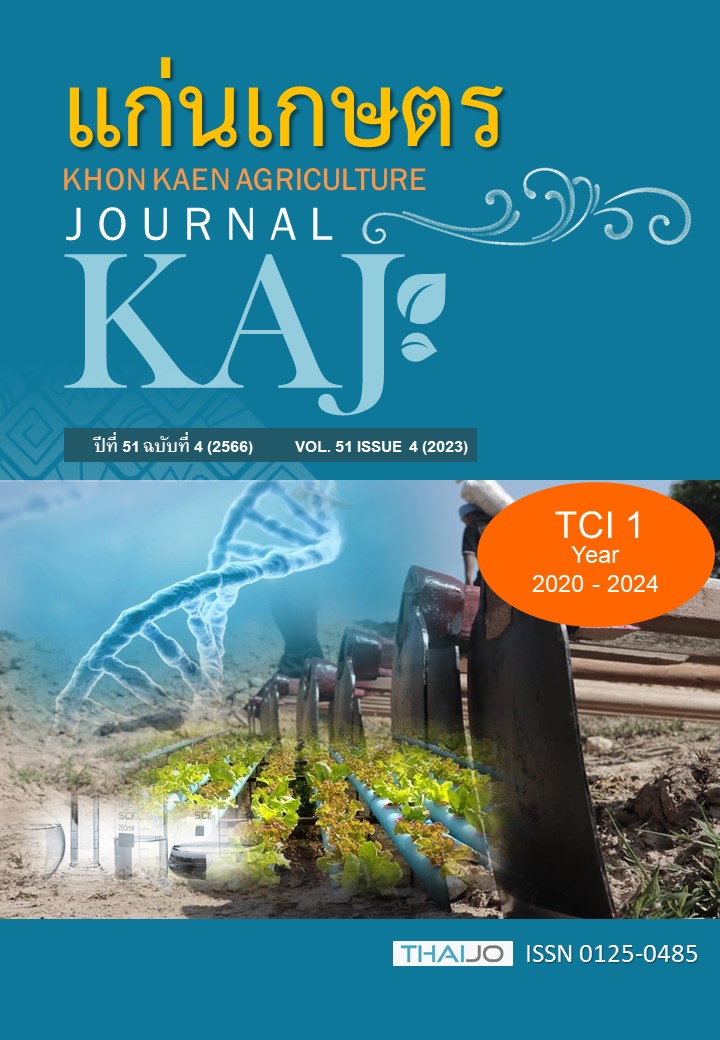ผลกระทบของการขาดน้ำในระยะสืบพันธุ์ต่ออัตราการแลกเปลี่ยนแก๊สในใบข้าวพันธุ์ไทย
Main Article Content
บทคัดย่อ
การขาดน้ำส่งผลกระทบต่อสรีรวิทยาและผลผลิตข้าว งานวิจัยนี้มีวัตถุประสงค์เพื่อศึกษาผลของการขาดน้ำต่ออัตราการแลกเปลี่ยนแก๊สในใบ มวลชีวภาพ และผลผลิตของข้าวที่ระยะสืบพันธุ์ ประเมินความทนทานต่อการขาดน้ำของข้าวไทย และหาลักษณะทางสรีรวิทยาที่เกี่ยวข้องกับการทนแล้งของข้าว วางแผนการทดลองแบบ Split plot in a randomized complete block design กำหนดให้ main-plot คือ การให้น้ำแตกต่างกัน 3 ระดับ คือ สภาพปกติ, ขาดน้ำปานกลาง และขาดน้ำรุนแรง และ sub plot คือ ข้าว 6 พันธุ์ คือ ขาวดอกมะลิ105, เจ้าหอมนิล, ไรซ์เบอร์รี่, สินเหล็ก, IR20 และ DH212 เก็บข้อมูลสถานะของน้ำในดินและน้ำในต้นพืชวัดอัตราแลกเปลี่ยนแก๊สในใบ น้ำหนักมวลชีวภาพและผลผลิต พบว่าสภาพที่ขาดน้ำทำให้ความชื้นดินและสถานะของน้ำในพืชลดลง ปากใบ (gs) ปิดแคบ ประสิทธิภาพการใช้แสงของระบบรับแสงสองในสภาพมีแสง (FPSII) และอัตราเคลื่อนย้ายอิเล็กตรอน (ETR) ลดลง ในขณะที่ความเข้มข้น CO2 ในช่องว่างระหว่างเซลล์ใบ (Ci) และอุณหภูมิใบ (Tleaf) สูงขึ้น ส่งผลทำให้อัตราสังเคราะห์แสงสุทธิ (Pn) และอัตราคายน้ำ (E) มีค่าลดลง การขาดน้ำยังทำให้น้ำหนักมวลชีวภาพและผลผลิตลดลงในข้าวทุกพันธุ์ โดยเจ้าหอมนิล และไรซ์เบอร์รี่สามารถทนทานต่อการขาดน้ำได้ดีทั้งในสภาพขาดน้ำปานกลางและรุนแรง พันธุ์ขาวดอกมะลิ105 และสินเหล็กค่อนข้างอ่อนแอต่อการขาดน้ำ และพบว่าผลผลิตแปรผันตามค่า Pn E และ gs อย่างมีนัยสำคัญทางสถิติ ซึ่งมีค่าความสัมพันธ์เท่ากับ 0.82**, 0.83** และ 0.84** ตามลำดับ ชี้ให้เห็นว่าพารามิเตอร์นี้สามารถใช้เป็นดัชนีประเมินความทนแล้งของข้าวได้
Article Details

อนุญาตภายใต้เงื่อนไข Creative Commons Attribution-NonCommercial-NoDerivatives 4.0 International License.
เอกสารอ้างอิง
กรมการข้าว. 2559. องค์ความรู้เรื่องข้าว: พันธุ์ข้าว. แหล่งข้อมูล: http://webold.ricethailand.go.th/rkb3/index.htm. ค้นเมื่อ 15 พฤษภาคม 2563.
กรมส่งเสริมการเกษตร. 2565. ระบบสารสนเทศการผลิตทางด้านการเกษตร: รายงานข้อมูลภาวะการผลิตพืช. แหล่งข้อมูล: https://production.doae.go.th/data-state-location/index. ค้นเมื่อ 1 พฤศจิกายน 2565.
ธีระรัตน์ อุบลรัตน์, เกศราภรณ์ จันทร์ประเสริฐ และวาสินี พงษ์ประยูร. 2560. การตอบสนองด้านสรีรวิทยาและจัดกลุ่มข้าวหอมพันธุ์ไทย 4 พันธุ์ต่อภาวะเครียดจากความเค็มจากเกลือโซเดียมคลอไรด์. วารสารวิทยาศาสตร์บูรพา. 22(2): 233-247.
นวรัตน์ อุดมประเสริฐ. 2558. สรีรวิทยาของพืชภายใต้สภาวะเครียด. สำนักพิมพ์แห่งจุฬาลงกรณ์ มหาวิทยาลัย, กรุงเทพฯ.
ปรียานุช ลาขุนทด, ปิยะดา ธีระกุลพิศุทธิ์, จิรวัฒน์ สนิทชน และโจนาลิซา แอล เซี่ยงหลิว. 2558. ผลของการขาดน้ำต่อการเปลี่ยนแปลงสถานะของน้ำในใบข้าวขาวดอกมะลิ 105 ที่โครโมโซม 9 บางส่วนถูกแทนที่ด้วยยีนทนแล้ง.วารสารวิจัย มหาวิทยาลัยขอนแก่น (ฉบับบัณฑิตศึกษา). 15(3): 46-55.
พลอยพิศ เพ็ญพิมพ์, คัทลียา ฉัตร์เที่ยง, ลพ ภวภูตานนท์, วินัย อุดขาว, ศิริพรรณ สุขขัง และสมนึก พรมแดง. 2565. การตอบสนองของปากใบและกระบวนการสังเคราะห์แสงภายใต้สภาวะเครียดจากเกลือที่ชักนำด้วยโซเดียมคลอไรด์ของข้าวพันธุ์ขาวดอกมะลิ 105 ในระยะแตกกอ. วารสารวิทยาศาสตร์เกษตร. 53(1): 77-93.
วสันต์ ปานนิ่ม, คัทลียา ฉัตร์เที่ยง, วินัย อุดขาว, ศิริพรรณ สุขขัง, สมนึก พรมแดง และสุนทรี ยิ่งชัชวาลย์. 2563. การตอบสนองของปากใบและกระบวนการสังเคราะห์แสงภายใต้สภาวะขาดน้ำจากการชักน้ำด้วยสารพอลิเอทิลีนไกลคอลของข้าวพันธุ์ขาวดอกมะลิ 105 (Oryza sativa L. ssp. indica cv. KDML105) ในระยะการเจริญเติบโตทางลำต้น. วารสารวิทยาศาสตร์เกษตร. 51(2): 90-106.
ศรีสังวาลย์ ลายวิเศษกุล และสุนทรี ยิ่งชัชวาลย์. 2554. อิทธิพลของความเข้มแสงต่อจุดชดเชยคาร์บอนไดออกไซด์และประสิทธิภาพคาร์บอกซิเลชันของใบผักโขม. วารสารวิทยาศาสตร์เกษตร. 42(2): 203-210.
ศูนย์วิทยาศาสตร์ข้าว. 2560. งานวิจัยและพัฒนาพันธุ์ข้าว. แหล่งข้อมูล: https://dna.kps.ku.ac.th/index.php/research-develop/rice-breeding-lab. ค้นเมื่อ 15 พฤษภาคม 2563.
สำนักงานเศรษฐกิจการเกษตร. 2565. ข้อมูลการผลิตสินค้าเกษตร: ตารางแสดงรายละเอียดข้าวนาปี. แหล่งข้อมูล: https://www.oae.go.th/assets/portals/1/fileups/prcaidata/files/rice%20varieties%2064.pdf. ค้นเมื่อ 1 ตุลาคม 2565.
สุนทรี ยิ่งชัชวาลย์, จินตณา บางจั่น และภูริพงศ์ ดำรงวุฒิ. 2544. พลังงานน้ำในรอบวันของใบส้มเขียวหวาน. น. 45-61. ใน: รายงานโครงการพัฒนาวิชาการข้อมูลพื้นฐานทางสรีรวิทยาของส้มเขียวหวาน. มหาวิทยาลัยเกษตรศาสตร์, นครปฐม.
Anjum, S.A., X. Xie, L. Wang, M.F. Saleem, C. Man, and W. Lei. 2011. Morphological, physiological and biochemical responses of plants to drought stress. African Journal of Agricultural Research. 6(9): 2026–2032.
Boyer, J.S. 1995. Measuring the Water Status of Plants and Soils. Academic Press, Inc.
Centritto, M., M. Lauteri, M.C. Monteverdi, and R. Serraj. 2009. Leaf gas exchange carbon isotope discrimination, and grain yield in contrasting rice genotypes subjected to water deficits during the reproductive stage. Journal of Experimental Botany. 60(8): 2325-2339.
Cha-um, S., S. Yoooyongwech, and K. Supaibulwatana. 2010. Water stress in the reproductive stage of four indica rice genotypes. Pakistan Journal of Botany. 42: 3387-3398.
Dhansu, P., N. Kulshreshtha, R. Kumar, A.K. Raja, S.K. Pandey, V. Goel, and B. Ram. 2021. Identification of Drought-Tolerant Co-canes Based on Physiological Traits, Yield Attributes and Drought Tolerance Indices. Sugar Tech. 23(4): 747-761.
Farooq, M., N. Kobayashi, O. Ito, A. Wahid, and R. Serraj. 2010. Broader leaves result in better performance of indica rice under drought stress. Journal of Plant Physiology. 13: 1066–1075.
Fischer, R.A., D. Rees, K.D. Sayre, Z.M. Lu, A.G. Condon, and A.L. Saavedra. 1998. Wheat yield progress associated with higher stomatal conductance and photosynthetic rate, and cooler canopies. Crop Science. 38: 1467–1475.
Foley, J.A., N. Ramankutty, K.A. Brauman, E.S. Cassidy, J.S. GerberJohnston, N.D. Mueller, C. O’Connell, D.K. Ray, P.C. West, and C. Balzer. 2011. Solutions for a cultivated planet. Nature. 478: 337-342.
Hussain, T., N. Hussain, M. Ahmed, C. Nualsri, and S. Duangpan. 2021. Responses of lowland rice genotypes under terminal water stress and identification of drought tolerance to stabilize rice productivity in Southern Thailand. Plants. 10(12): 2565.
Jain, R., A. Singh, S. Singh, S.P. Singh, V.K. Srivastava, A. Chandra, A.D. Pathak, and S. Solomon. 2017. Physio-Biochemical Characterization of Sugarcane Genotypes for Waterlogging Tolerance. World Journal of Agricultural Sciences. 13(2): 90-97.
Kumar, A., S. Dixit, T. Ram, R.B. Yadaw, K.K. Mishra, and N.P. Mandal. 2014. Breeding high-yielding drought-tolerant rice: Genetic variations and conventional and molecular approaches. Journal of Experimental Botany. 65(21): 6265–6278.
LI-COR Inc. 2002. LI-6400 system Photosynthesis, Fluorescence, Respiration. Printed in the U.S.A.
Long, S.P., X.G. Zhu, S.L. Naidu, C.A. Raines, and D.R. Ort. 2005. Limits to efficiencies of primary production-constraints and opportunities. In Yields of farmed species: constraints and opportunities in the 21st century, pp. 167-191. In proceedings of a University of Nottingham Easter School Series, June 2004. Sutton Bonington, UK.
Malumpong, C., S. Cheabu, C. Mongkolsiriwatana, W. Detpittayanan, and A. Vanavichit. 2019. Spikelet fertility and heat shock transcription factor (Hsf) gene responses to heat stress in tolerant and susceptible rice (Oryza sativa L.) genotypes. The Journal of Agricultural Science. 157(4): 283-299.
Ohashi, Y., N. Nakayama, H. Saneoka, P.K. Mohapatra, and K. Fujita. 2009. Differences in the responses of stem diameter and pod thickness to drought stress during the grain filling stage in soybean plants. Acta Physiologiae Plantarum. 31(2): 271-277.
Pandey, V., and A. Shukla. 2015. Acclimation and tolerance strategies of rice under drought stress. Rice science. 22(4): 47-161.
Pitaloka, M.K., R.S. Caine, C. Hepworth, E.L. Harrison, J. Sloan, C. Chutteang, C. Phunthong, R. Nongngok, T. Toojinda, S. Ruengphayak, S. Arikit, J.E. Gray, and A. Vanavichit. 2022. Induced genetic variations in stomatal density and size of rice strongly affects water use efficiency and responses to drought stresses. Frontiers in Plant Science. 13.
Raman, A., S.B. Verulkar, N.P. Mandal, M. Variar, V.D. Shukla, L. Dwivedi, B.N. Singh, O.N. Singh, P. Swain, A.K. Mall, S. Robin, R. Chandrababu, A. Jain, T. Ram, S. Hittalmani, S. Haefele, H.P. Piepho, and A. Kumar. 2012. Drought yield index to select high yielding rice lines under different drought stress severities. Rice. 5(31): 1–12.
Roonprapant, P., A. Arunyanark, and C. Chutteang. 2021. Morphological and physiological responses to water deficit stress conditions of Robusta coffee (Coffea canephora) genotypes in Thailand. Agriculture and Natural Resources. 55(3): 473-484.
Rungrat, T., and C. Poothab. 2019. Short-term water deficit stress induces anthocyanin accumulation and changes in grain yield and yield components in colored rice grain. Agriculture and Natural Resources. 53(3): 292-297.
Spectrum technologies, lnc. 2017. Field scount TRD150 Soil Moisture Meter, product manual. Printed in the U.S.A.
Taiz, L., and E. Zeiger. 2002. Plant physiology. 3rd Edition. Sinauer Associates, Inc.
Wang, J.H., L.H. Geng, and C.M. Zhang. 2012. Research on the weak signal detecting technique for crop water stress based on wavelet denoising. Advanced Materials Research. 424/425: 966–970.
Yang, X., B. Wang, and L. Chen. 2019. The different influences of drought stress at the flowering stage on rice physiological traits grain yield and quality. Scientific Reports. 9: 3742.


